The bark beetle between forestry and forest conservation
We already reported on the effects of climate change on monoculture forests and the associated susceptibility of conifers to the bark beetle in the articleThe renaturation of the Niers and other near-natural areas between Aspermühle and Kessel Part 2'.
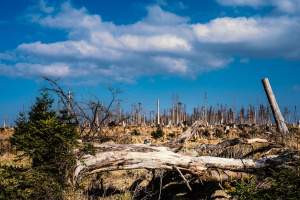
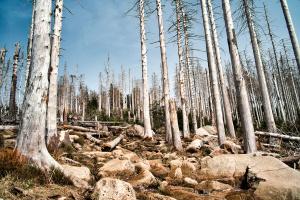
This topic is dealt with in detail in the following article.
The article was written as a term paper in 2021 as part of Anna-Lea Ortman's landscape ecology master's programme, who kindly made the work available to us for our blog.
Table of contents:
1. introduction
2. Biology & Ecology
3. Forestry
4. Forest Policy
5. Forest nature conservation - case study: Bavarian Forest National Park
6. Conclusion
7. Literature
List of figures:
Fig. 1 Appearance of the imagines of the spruce bark beetle and copper engraver and their
feeding patterns (modified after REITTER 1916, NIESAR et al. 2019, STMELF 2020)
Fig. 2 Trends in bark beetle outbreaks in the Anthropocene
(BIEDERMANN et al. 2019)
Fig. 3 Ecosystem services provided by forests (BÜRGER- ARNDT 2012)
List of tables:
Table 1 Figures from the forestry sector (taken from BIEDERMANN et al. 2019,
DESTATIS 2020)
1 Introduction
We often associate the topic of bark beetles with images of large areas of dead spruce forests, as shown in landscape photographs from the Harz Mountains. Anyone who frequently goes into the forest will probably have seen one or two spruce stands with traces of the bark beetle, be it dried trees and standing deadwood or already cleared bare areas. In the course of the discourse on forest dieback, which was very present in the 1980s and is now flaring up again around 30 years later, bark beetle mass propagation and the links to climate change play a decisive role (HENNING, 2020: 34). In nature conservation and forestry policy, the bark beetle is regularly the subject of discussions about the sustainability and climate resilience of forests and their management. Depending on the perspective - forest nature conservation or forestry - the bark beetle and its impact on forest ecosystems is assessed very differently.
After an introduction to the ecology of the two best-known native spruce-colonizing bark beetle species, the perspective of forestry and the forestry bark beetle management of these species will be explained. After an excursion into current issues of forest policy, the view of nature conservation on the bark beetle is examined in more detail on the basis of findings from the Bavarian Forest National Park. The views of the regional tourism industry and the local population are also compiled.
2. biology & ecology
Systematics
The species group of bark beetles (Scolytinae) is a subfamily within the family of weevils (Curculionidae). The weevils belong to the order of beetles (Coleoptera) within the class of insects (Insecta) (MUGU et al. 2018).
Species While around 6,000 bark beetle species are known globally, 150 of these occur in Europe(WALDHILFE 2021). Less than 1 % of these are known to cause large-scale tree mortality (MORRIS et al. 2016). The best-known bark beetle species in Central Europe and Germany include the spruce bark beetle (Ips typographus) and the copper engraver (Pityogenes chalcographus). While both species are mainly specialized on the native red spruce (Picea abies), the spruce bark beetle rarely colonizes larch and pine, the copper engraver occasionally also pine, larch and Douglas fir, rarely fir (LWF 2020a). The following explanations on the biology and ecology of bark beetles are limited to the two species mentioned and are not applicable to all species of the subfamily Scolytinae. 2
External characteristics
As can be seen in Figure 1, the imago of the spruce bark beetle is about twice as large as that of the copper engraver at 4 - 6 mm. The spruce bark beetle and the copper engraver are bark-breeding beetles that leave behind the bark in the nutrient-rich bast species-specific feeding patterns that give the group of bark beetles its name. While these have the form of a multi-armed longitudinal corridor in the bark beetle, they have the form of a star-shaped corridor in the copper beetle. (NIESAR et al. 2019) Fig. 1 Appearance of the imagines of the spruce bark beetle and copper engraver and their feeding patterns (modified after NIESAR et al. 2019)
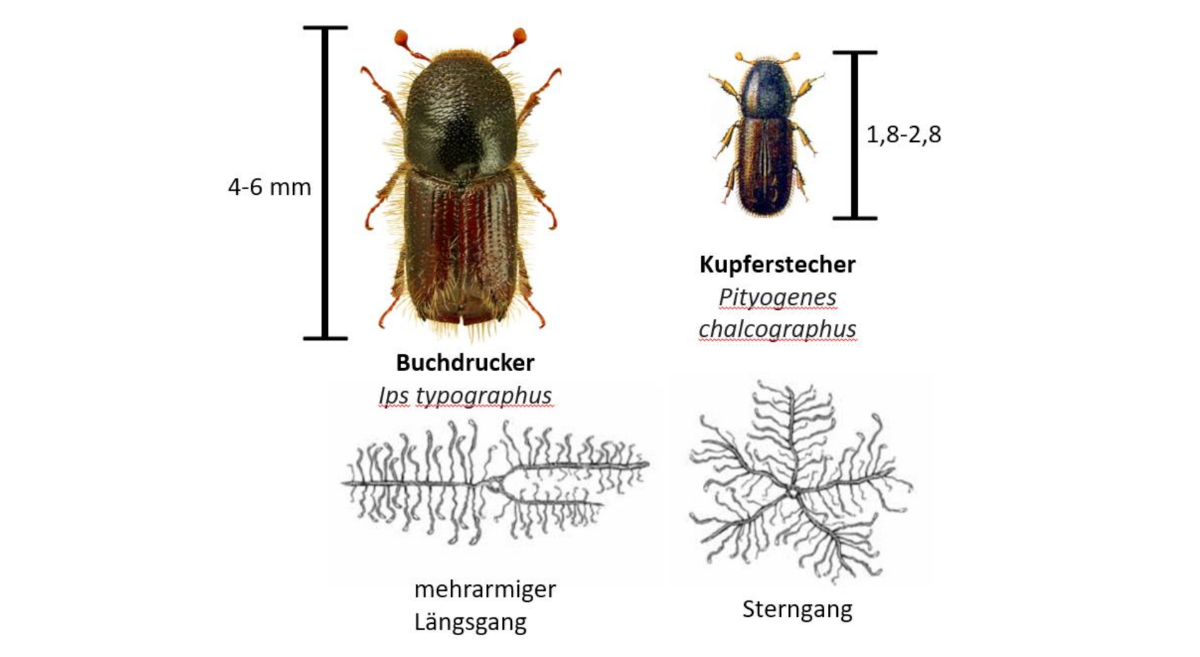
Fig. 1 Appearance of the imagines of the spruce bark beetle and copper engraver and their feeding patterns (modified after NIESAR et al. 2019)
Reproduction & life cycle
The bark beetles fly between April and September. From temperatures of 16.5 °C and daylight hours of 14 hours, the adult beetles swarm out of their winter quarters. After approaching a host tree, usually spruce, the male bores into the bark of the trunk and creates a so-called collecting chamber. From here, other males and females are attracted by the release of pheromones (NIESAR et al. 2019). The copper engraver and the spruce bark beetle reproduce polygamously (LWF 2020b). Over a period of 2 - 5 days, the males mate with several females (SIX & WINGFIELD 2011).
The tree reacts to colonization by releasing resin via the resin canals. When the tree is colonized by 200 - 1,000 beetle individuals or more, the tree's defensive reaction comes to a standstill sooner or later, depending on its vitality (WEGENER 2018). From this point onwards, the beetles emit pheromones 3 again. This time to deter further beetles from colonizing their host tree (SIX & WINGFIELD 2011).
After mating has taken place, the females create a mother duct from the collecting chamber in which they lay their eggs. This allows the adult females to fly out again 1 - 2 weeks after mating and create so-called sibling broods. Like all beetle species (Coleoptera), bark beetles undergo holometabolous development. The hatched larvae eat their way through the nutrient-rich bast from the mother's tunnel and can spread over a large area in the bark along the trunk. This is followed by the pupal stage and the hatching of the juvenile beetle. The latter carries out a maturation feeding behind the bark before it flies out for the first time. The development from the egg to the swarming of the young beetles is highly temperature-dependent and takes 6 - 10 weeks. Bark beetles can live up to 2 years. (LWF 2020b)
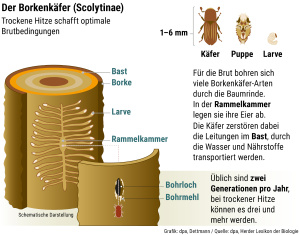
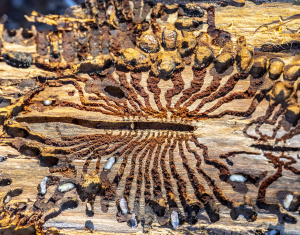
Role in the ecosystem
Bark beetles are a natural component of forest ecosystems and are functionally important as primary consumers and decomposers (LWF 2020c). The population development of bark beetles depends on various factors in the forest ecosystem. High temperatures and a lack of precipitation favor a high reproduction rate. Drought and heat in summer as well as mild winters such as in the drought years 2018 - 2020 stress potential host trees such as spruce, which, as a shallow-rooted tree, was particularly affected by forest damage according to the 2019 Forest Condition Report (DELB et al. 2019). Spruce is also particularly affected by storm events. Storm-damaged wood, such as that caused by windthrow and wind breakage, provides a suitable habitat for bark beetles. In addition, heavy snow loads and ice in winter can lead to snow and ice breakage and further increase the breeding habitat available for bark beetles (LWF 2020b).
The older the spruce, the more susceptible it is to insects such as the bark beetle (SEIDL et al. 2016). Extensive old spruce occurrences in a monotonous stand structure offer the bark beetle continuous landscape connectivity, thus favoring rapid spread (WERMELINGER 2004).
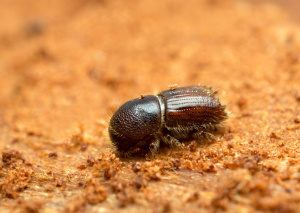
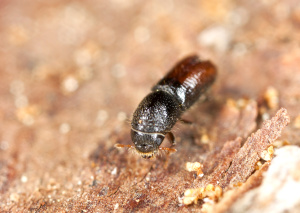
Under favorable weather conditions, up to 3 generations and 2 additional sibling broods per generation can be created within one vegetation period, resulting in cyclically recurring mass propagation (LWF 2020b). These cannot be prevented or interrupted by all natural antagonists. The antagonists include the spruce itself (resin flow), predators such as the ant beetle (Thanasimus formicarius) and woodpeckers, parasitoids such as ichneumon wasps and earth wasps as well as pathogens (fungi). Mass propagation ends due to weather developments that are unfavorable for bark beetles (WALD UND HOLZ NRW 2019, LWF 2020b).
Parasitoids as beneficial insects
Historical classification & influence of climate change
As can be guessed from the ecology of bark beetles, storm events, drought and heat have always favored mass propagation. The susceptibility of spruce monocultures to the combination of storms and the bark beetle was already known in the 19th century (HENNING, 2020: 35) and was already the subject of forestry publications in the middle of the last century (THALENHORST 1953). At the same time, until the 1960s, foresters learned how to efficiently destroy beech and oak regeneration in spruce stands (HENNING, 2020: 40). Due to large-scale spruce afforestation in the first half of the 20th century, spruce monocultures still dominate the forest landscape in many places today. Since the 1970s, bark beetle mass propagation has had an increasing impact on forests in North America and Europe (MORRIS et al. 2016). According to SEIDL et al. (2016), the amount of damaged wood caused by bark beetles has increased sevenfold in the last four decades. The summers of 2018 and 2019 were comparable to that of 2003, which was dubbed the summer of the century at the time (DELB et al. 2019). The last few decades have shown that advancing climate change is leading to an intensification of bark beetle outbreaks (HLÁSNY et al. 2019). As droughts and storm events are likely to become more frequent due to climate change, models predict more frequent and more severe bark beetle mass propagations in the course of the Anthropocene (BIEDERMANN et al. 2019) (see Fig. 2). The long-term developments of bark beetle mass propagations can therefore be regarded as an indicator of the progressive climate change that is increasingly affecting our latitudes. Today, forestry experts such as Munich silviculture professorRupert Seidl describe spruce cultivation below an altitude of 800 m as a "silvicultural mistake" (HENNING 2020: 42).

Fig. 2 Developments in bark beetle outbreaks in the Anthropocene (BIEDERMANN et al. 2019)
3 Forestry
Figures from the forestry sector
Bark beetle mass propagations follow primary damage events such as droughts and storms. So-called beetle damage wood is therefore a secondary phenomenon. As a result of the storms Burglind and Friederike and the extreme summer of 2018, up to 4 generations of bark beetles were able to develop in NRW (WALD UND HOLZ NRW 2019). As shown in Table 1, the wood losses caused by the bark beetle in Europe in 2018/19 were more than two and a half times higher than in the period from 2002 to 2010 (BIEDERMANN et al. 2019). The amount of wood damaged by insect pests almost tripled from 2018 to 2019 (DESTATIS 2020). These developments are accompanied by an oversupply of wood (especially spruce) on the European and domestic German timber market, which in turn leads to a drop in prices. Depending on the tree species, timber prices have fallen to a quarter of the long-term average (HLÁSNY et al. 2019, PNN 2019). According to calculations by the Arbeitsgemeinschaft deutscher Waldbesitzer e.V. (AGDW) - the largest interest group for non-state forestry in Germany - a loss of 2.5 billion euros was incurred in 2018/19 (HENNING 2020: 43). Companies and forest owners who rely on spruce in monocultures are the most affected by the economic damage. In view of the long forestry rotation periods of at least 60 years, the timber losses and damage are particularly severe.

Countermeasures
Forest protection, an area of forestry that can be seen as a counterpart to plant protection in agriculture, is dedicated to combating pests and diseases in commercial forests. Various measures against the bark beetle are part of forestry practice. They aim to reduce the initial bark beetle density in the following year. For example, stand and tree inspections are carried out throughout the year in order to be able to fell infested trees as early as possible and remove them from the stand (LWF 2020b). According to projections by WALD UND HOLZ NRW (2019), 8,000 new trees can be infested the following spring if an infested tree is overlooked. As the copper engraver settles higher up on the trunk in the canopy, the residual crown wood of felled trees in infested stands should also be mulched or chopped. Pheromone traps are used to monitor bark beetle population developments during swarming periods, which serves as a basis for national and state-wide reports on current bark beetle activity. In the area of logistics, safety distances of at least 500 m are maintained between timber piles and potentially endangered host tree populations during timber storage. Where this is not possible, wet or foil storage facilities prevent bark beetles from entering or leaving the woodpile. Forest certification in accordance with the PEFC standard also permits the use of insecticide-treated nets(Storanet) to cover the wood piles. In addition, wood piles are also treated with insecticides by spraying in accordance with the ultima ratio principle, i.e. when the aforementioned measures have been exhausted (LWF 2020c). Insecticide treatment of the stands themselves - as was done, for example, due to the barnacle butterfly in 2019 on more than 5,000 ha of forest area in Brandenburg(NABU 2019) - is not permitted in the case of bark beetle infestation. In FSC and natural forest-certified forests, insecticides are generally not used as part of bark beetle management. The aforementioned short-term measures serve to contain economic damage, but cannot prevent bark beetle mass propagation (DELB et al. 2016).
In the medium term, "good silviculture" is considered the most effective forest protection measure (HENNING 2020: 34). Mixed stands are more resistant and resilient to bark beetle mass propagation than pure stands of the same age. In terms of landscape connectivity, more resistant and mixed stands slow down the speed at which bark beetles spread. As a result, spruce monocultures in Germany in particular are increasingly being converted into mixed stands as part of forest conversion programs. According to HLÁSNY et al. (2019), silviculture and management should be designed at the landscape level, but this is made more difficult by different small-scale adjacent ownership structures.
Excursus: The spruce in forestry
According to the Potential Natural Vegetation, the natural range of the red spruce (Picea abies) is limited to the high altitudes (TÜXEN 1956). At low altitudes, spruce is not adapted, comes under drought stress more quickly and is more susceptible to insects such as bark beetles (HENNING, 2020: 35). The fact that spruce - often grown in monoculture - is nevertheless the most common German forest tree species and accounts for 25 % of the forest area (BMEL 2017) is due to the favorable properties of spruce wood, which are suitable for construction purposes. Due to its fast growth and ability to establish itself on degraded soils, it was also cultivated on a large scale outside its natural range after the periods of desertification in the 18th and 19th centuries and after the world wars (DELB et al. 2016, HENNING 2020: 39). To this day, it is considered the bread and butter tree of forestry (A GDW 2017). In 2016, 90 % of income from timber harvesting was generated with spruce wood (SDW 2016). At the same time, increasing bark beetle damage makes it clear that a rethink in forestry is necessary, which is already evident in forest conversion practices in many places. In the USA, the current and natural distribution areas of bark beetle host tree species are still largely congruent. According to DELB et al. (2016), the regular bark beetle outbreaks in the USA make it clear that limiting a tree species to its natural range would not provide any protection against bark beetle mass propagation in Europe either. The occurrence of a tree species outside its natural range is usually associated with the loss of its ecological optimum and can lead to increased susceptibility outside the natural range.
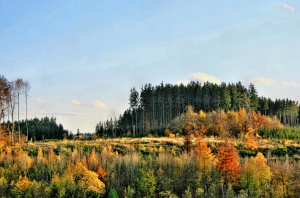
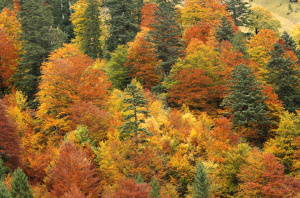
At the same time, habitat conditions are also changing within natural ranges as a result of climate change. Even if global warming is limited to 2°C, the red spruce in the central European low mountain ranges would no longer be at its optimum (WEGENER 2018). Climate change is fundamentally altering the conditions in mountain forests. 30-year studies in spruce forests in the Harz National Park indicate that spruce stands there are already collapsing at a younger age of 80 - 120 years due to bark beetles and no longer reach the species-rich age (180 - 250 years) and decay phases (250 - 325 years). While WEGENER (2018) assumes that these ecosystem phases will be absent in the future, modeling predicts that more frequent and more severe bark beetle outbreaks will favor fundamental changes in ecosystems and species composition at high altitudes and latitudes. This may result in the emergence of novel ecosystems(M ORRIS et al. 2016, BIEDERMANN et al. 2019).
4. forest policy
Social relevance
A wide range of economic, social and ecological demands are placed on forests in Germany. This can be seen in the variety of supporting, providing, regulating and cultural ecosystem services that forests provide for humans (Fig. 3). Forests are the basis for 1.1 million jobs, some of which are directly in forestry, others in the sawmill industry or in the wood processing industry (BMEL 2017). In comparison, the coal industry accounted for around 90,000 direct, indirect or induced jobs in 2020 (DEBRIV 2020). In addition to jobs, the forest is an important place of recreation for many people. The average German visits the forest 28 times a year (FNR 2019).
Bark beetle outbreaks have an impact on a range of ecosystem services provided by forests at local and regional level. A meta-analysis by THOM & SEIDL (2016) found that the negative impacts predominate in all 4 areas - supporting, providing, regulating and cultural. According to MORRIS et al. (2016), land values, the amount of merchantable timber and the aesthetics and recreational value of landscapes and thus tourism can be negatively affected. In the area of regulating ecosystem services, air purification, water purification, soil retention capacity and climate regulation tend to be impaired (HLÁSNY et al. 2019). Forests, which are basically net carbon sinks, can become net carbon sources over a period of 5 - 20 years (KURZ et al. 2008, HANSEN 2014). However, the sensitivity and resilience of ecosystem services to disturbances vary regionally and depend in part on the ability of private and public actors to manage bark beetle-influenced landscapes (MORRIS et al. 2016).
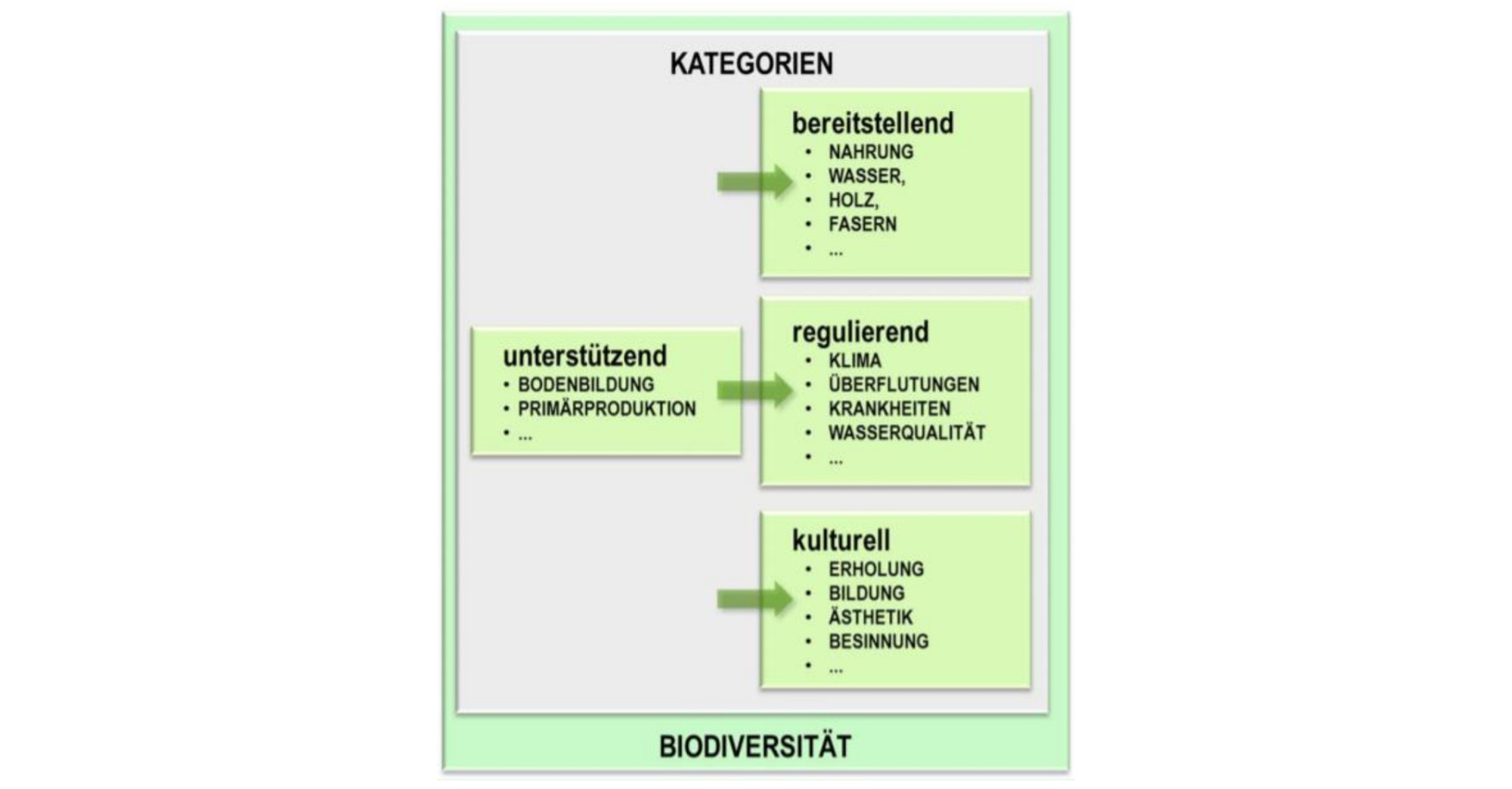
Fig. 3 Ecosystem services provided by forests (BÜRGER- ARNDT 2012)
Forest premiums 2019/20
Unlike agricultural policy, forest policy is the responsibility of the EU member states and, in Germany's federal system, is partly the responsibility of the federal states within the framework of concurrent legislation.
Following the drought years of 2018/19 and the associated forest damage, the interest groups Arbeitsgemeinschaft deutscher Waldbesitzer e.V. (AGDW) and Familienbetriebe Land und Forst (FABLF) pointed out the urgency of additional financial support for private forest owners. In their climate paper from July 2019, they also called for a general reward for forest ecosystem and climate protection services similar to land subsidies in agriculture (AGDW & FABLF 2019, HENNING 2020: 46). While the latter has not yet been implemented, forest owners have been provided with a total of 1.5 billion euros by the federal and state governments to deal with the damage caused by drought, storms and beetles(NABU 2020). The 500 million trees program has received particular attention in the press, advertised by Agriculture Minister Julia Klöckner with the words: "There has hardly been a comparable loss of forest in the past."(FAZ 2019). Advocates of near-natural forests criticized the inadequate conditions from an ecological point of view when using state subsidies or tax money for reforestation, e.g. regarding the choice of tree species. While Peter Wohlleben commented on the 500 million trees program as follows: "Klöckner wants to burn money" and called for an end to reforestation with conifers (DNN 2019), NABU (2020) also insists on a closer link between forest premiums and ecological services: "Public money only for public services".
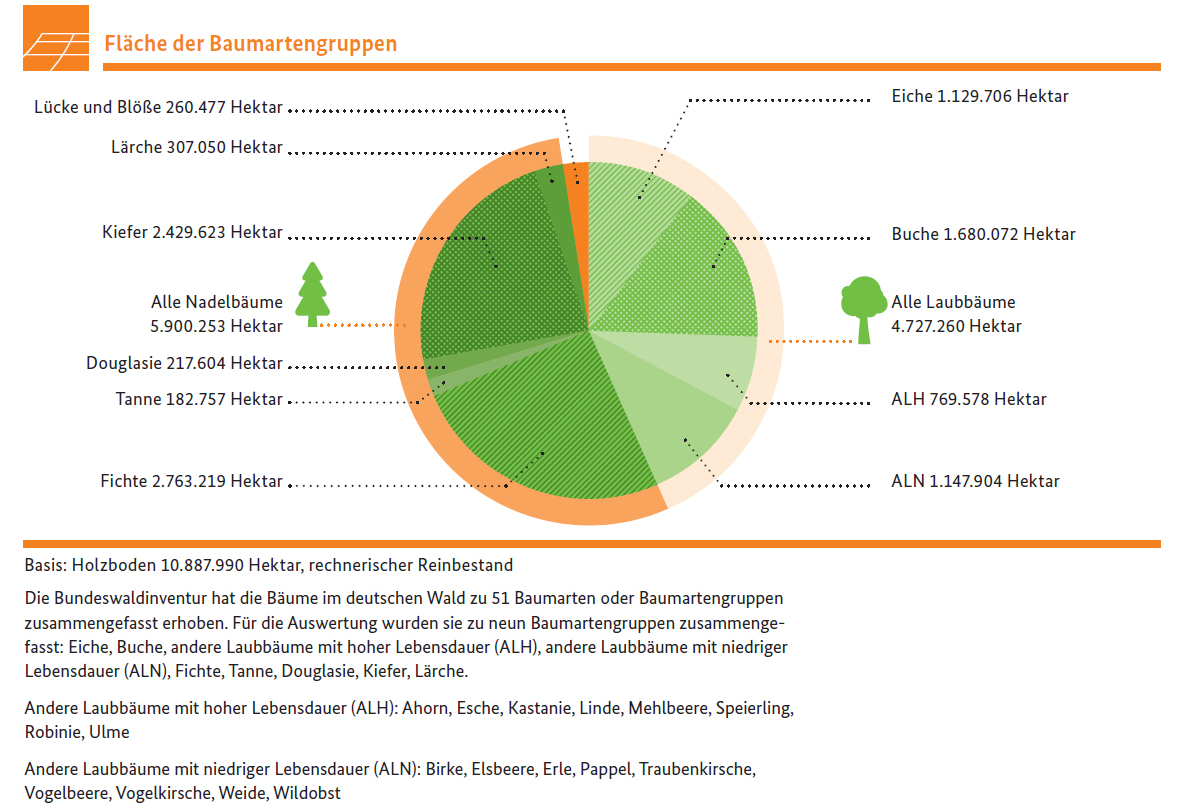
Source:BMEL Federal Forest Inventory 2012
Proportion of coniferous wood in German forests
There are conflicts of interest between forestry and nature conservation policy with regard to the desired future proportion of coniferous wood in German forests. In view of the omnipresent competition for land, the objectives of the forest strategy adopted for the first time in 2011 and again in 2020 by the Federal Government and the objectives of the National Biodiversity Strategy adopted in 2007 are in tension (JOB & MAYER 2012, WALD UND HOLZ NRW 2014). The goal of supplying Germany as a current net importer of softwood with as much domestic softwood as possible(BMEL 2020) is in competition with the goal of establishing near-natural deciduous and mixed forests on more forest area and only cultivating softwoods adapted to the location(BMU 2007). The 2 % wilderness target of the biodiversity strategy does not appear to be achievable in the next few years (BMEL 2020). With less than 1 % of the country's land under process protection, it was not even half achieved in 2019 (BRG 2019).
5 Forest nature conservation - case study: Bavarian Forest National Park
In the Bavarian Forest National Park - established in 1970 as the first German national park - process protection is the guiding principle. Forest protection measures against the bark beetle are only carried out in a 500 m wide border zone (forest protection zone) in order to protect adjacent commercial forests from bark beetle migration from the national park. For several decades, the national park has served as an open-air laboratory for large-scale research into a wide range of issues from forest and disturbance ecology to acceptance and conflict research. Despite the proven ecological importance of the national park as a refuge for rare and endangered species, there are still opponents of the national park in the region (MICHLER et al. 2019).
The mass proliferation of bark beetles in the 1980s led to massive protests in the Bavarian Forest against the national park idea of "lettingnature be nature". The citizens' movement for the protection of the Bavarian Forest, which is critical of the national park, is still demanding widespread bark beetle control today (BAYERWALDSCHUTZVEREIN, 2017). This demand was supported by some local politicians in the past in particular. In 1989, the mayor of the municipality of Mauth proclaimed: "If the forest dies, then my municipality dies with it." (BIBELRIETHER 2017:115 in ASCHENBRAND & MICHLER 2019). This reflects the strong concerns of the first decades. At the time, the local and national population was concerned that the around 6,000 ha of spruce forests infested by the bark beetle would not green up again (ASCHENBRAND & MICHLER 2019, ZEIT 2020a). There were also concerns about the preservation of drinking water quality and the loss of the familiar landscape and homeland, criticism of the wasteful use of wood as a resource (SEIDL et al. 2016) and arguments that capercaillie protection was incompatible with the large-scale destruction of spruce forests. In winter, the capercaillie feeds on spruce needles, among other things (WANNINGER 2019).
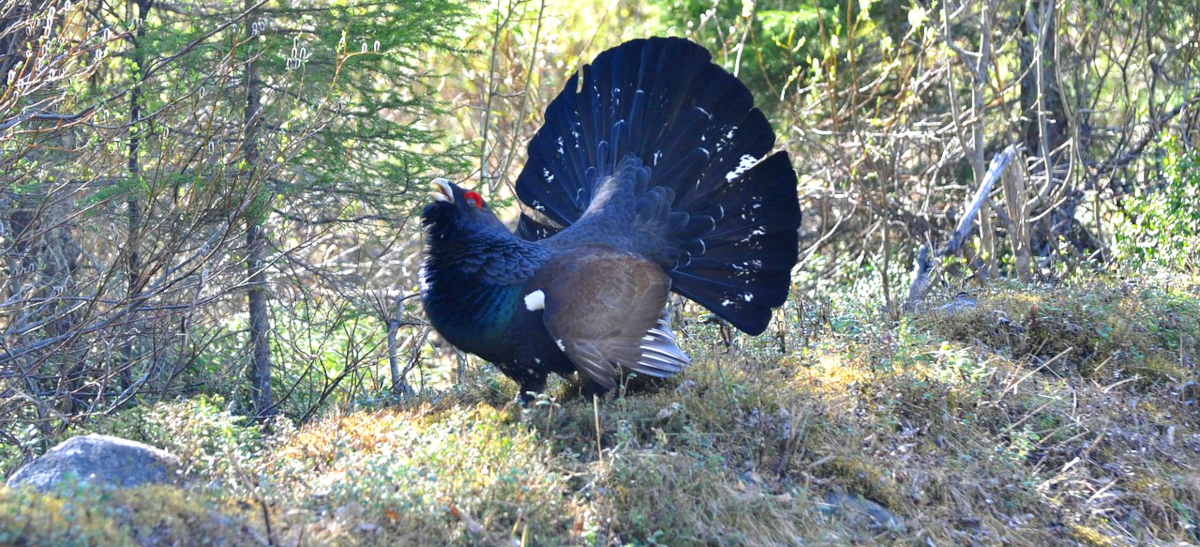
Capercaillie during courtship
From the very beginning, nature conservation associations and tourism organizations were among the supporters of the national park. To this day, they criticize clear-cut areas and soil damage caused by bark beetle management within the forest protection zone. They demand the complete cessation of bark beetle management in the national park area. (WANNINGER 2019)
While the majority of people were still skeptical about the national park in a regional survey conducted in 1988, 77% of respondents were already in favor of the continued existence of the national park in 2007 and as many as 86% in 2018 (WANNINGER 2019). In October 2020, it was decided to expand the national park by around 600 hectares, making it the largest forest national park in Germany once again(ZEIT 2020b). Acceptance of the national park in the region has increased significantly over the years (ASCHENBRAND & MICHLER 2019). The ecological, social and economic findings of recent decades, which are summarized below, have certainly contributed to this.
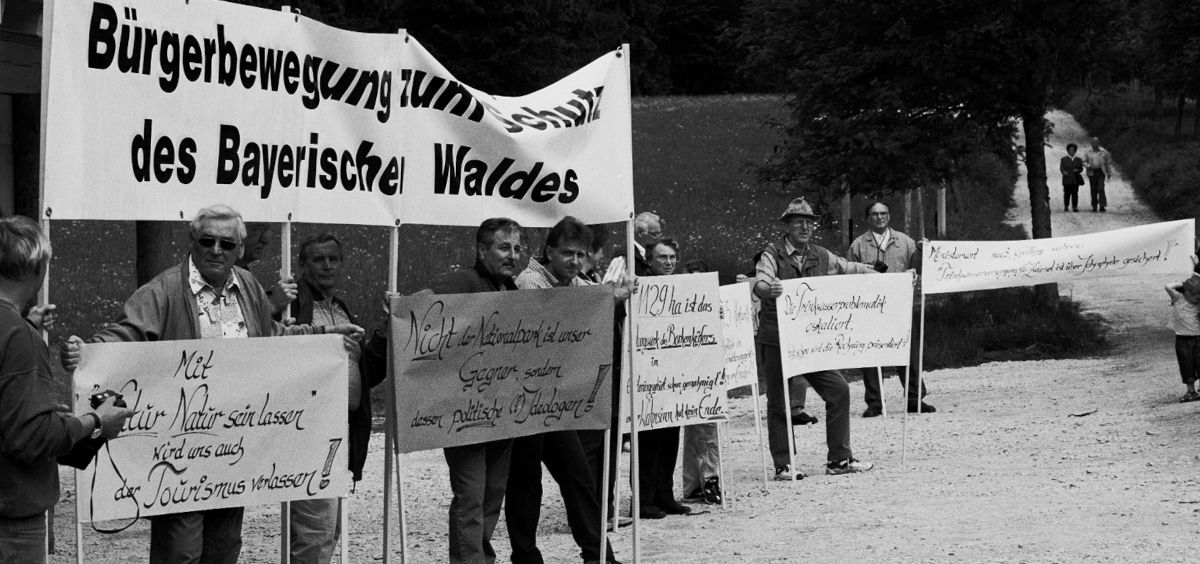
Protest against the Bavarian National Park at the 25th anniversary celebrations Source: Bavarian Forest National Park Administration
As far as forest ecological aspects are concerned, the initial arguments against the national park have been refuted. Within just a few decades, forests with a richer structure and species have developed in the national park as a result of the bark beetle mass propagation, which has also benefited the capercaillie along with several 1,000 other species (ASCHENBRAND & MICHLER 2019, HLASNY et al. 2019, ZEIT 2020a). According to a 28-year long-term study, drinking water limits were not exceeded due to bark beetles (BEUDERT et al. 2015).
The national park has proven to be a lucrative model for the regional economy. According to calculations by JOB & M AYER from 2012, the national park provides more jobs in the region and a higher regional economic value added compared to scenarios of forestry and, to a lesser extent, tourism use. The steady increase in visitor numbers up to 2019 (2019: 1.3 million) and regional economic value added (2019: € 21 million) confirm this assessment (WANNINGER 2019, BR 2020).
Conflict research has established that data and facts alone are not enough to convince people. Transparent dialog and participation processes are needed to address the concerns and wishes of the local population. Over the years, local decision-makers have increasingly responded to this (WANNINGER 2019). The assessment of large-scale bark beetle-influenced landscapes depends heavily on personal socialization. ASCHENBRAND & MICHLER (2019) distinguish between different "logics" that are used by nature conservationists, the tourism industry or the local population. According to the nature conservation logic, landscapes are measured on the basis of their ecological value and indicators such as biodiversity or the course of natural dynamics and processes. Large-scale disturbance events that result in a lot of deadwood remaining in the ecosystem are considered ecologically valuable, as they support many rare species. 20 % of forest species are considered to be dependent on deadwood(WALDWISSEN 2021).
Thus, landscapes such as those currently found in the Harz National Park or those that characterized the landscape in the Bavarian Forest in the 1990s can be considered positive and valuable from a nature conservation perspective. According to tourism logic, it is above all landscape stereotypes that want to be promoted. As long as the tourism concept of national parks serves such images, large areas of forests infested by bark beetles do not appear to diminish the appeal of national parks. Natural phenomena, on the other hand, can even be interesting starting points for environmental education programs. The assessment is often more negative and emotional on the part of the local population, based on what ASCHENBRAND & MICHLER (2019) call the logic of home. The yardstick for the value of landscape here is often familiarity. Changes to the space constructed as home tend to be received problematically.
6 Conclusion
Findings from ecological and climatological research suggest that more severe and more frequent bark beetle mass propagation can be seen as an indicator of advancing climate change. The level of knowledge on the bark beetle and copper engraver is considered sufficient to derive recommendations for action in forestry and nature conservation for the management of forests or the management of protected areas. Nevertheless, even after more than 200 years of bark beetle research, the interactions between various drivers of mass propagation and collapse are still not fully understood. In particular, there is still insufficient ecological knowledge about bark beetle species that have been less relevant to forestry to date (MORRIS et al. 2016, BIEDERMANN et al. 2019). From a forestry perspective, the bark beetle and copper engraver are primarily seen as pests. Climate change and global change pose increasing challenges for forestry (BIEDERMANN et al. 2016, SEIDL et al. 2016, HLASNY et al. 2019). Due to range shifts caused by climate change and the introduction of species through global trade, which cannot be completely prevented, it cannot be ruled out that additional bark beetle species or species from other families will cause increasing damage to wood in the future. Forest policy stakeholders are called upon to adapt the political framework to changing environmental conditions and social demands so that the diverse demands placed on forests can be met in the future. From a nature conservation perspective, the bark beetle can be seen as a key species and catalyst for natural forest development and forest wilderness and can act as a means of exerting pressure to pursue the goals of the National Biodiversity Strategy. In national park regions, it is the task of nature conservation to involve the local population and local economic sectors, such as the tourism industry, in the development of local concepts. This is the only way that large-scale changes to the landscape and the area that has been constructed as a home can be supported. At a supraregional level, it is important to strengthen the understanding of nature through environmental education in order to promote acceptance and an aesthetic appreciation of natural dynamics (ASCHENBRAND & MICHLER 2019).
7. literature
Literature AGDW - DIE WALDEIGENTÜMER (2017): FICHTE WICHTIGER BAUM FÜR NACHHALTIGE FORSTWÄTSCHAFT UND KLIMASCHUTZ. https://www.waldeigentuemer.de/fichte-wichtiger-baum-fuer-nachhaltige- forstwirtschaft-und-beudeklimaschutz/ (last call: 10.01.2021)
AGDW DIE WALDEIGENTÜMER & FABLF FAMILIENBETRIEBE LAND UND FORST (2019): Achieving climate targets - preserving forests, rewarding forest ecosystem services! https://www.waldeigentuemer.de/wp- content/uploads/2019/08/Klimapier_AGDW_FabLF_Final.pdf (last call: 10.01.2021)
BÜRGER- ARNDT, R. (2012): Forest functions and ecosystem services in the context of current scientific and political discourses. https://www.bfn.de/fileadmin/MDB/documents/ina/vortraege/2012/2012-OekonomiePraxis-III-Buerger-Arndt.pdf (last accessed: 10.01.2021)
ASCHENBRAND, E. & T. MICHLER (2019): Disturbed homeland - National parks between nature conservation, tourism and local acceptance. In: Nature conservation and landscape planning 51 (4), pp. 158-163.
BAYERISCHER RUNDFUNK (BR) (2020): On the road with a ranger in the Bavarian Forest National Park. https://www.br.de/nachrichten/bayern/mit-einer-rangerin-unterwegs-im-nationalpark-bayerischer-wald,S5wF0Tb (last call: 17.01.2021)
BAYERWALDSCHUTZVEREIN - BÜRGERBEWEGUNG ZUM SCHUTZ DES BAYERISCHEN WALDES e.V. (2017): Our goals and tasks. http://bayerwald-schutzverein.de/ziele-des-vereins (last call: 4.01.2021)
BEUDERT, B., BÄSSLER, C., THORN, S., NOSS, R., SCHRÖDER , B., DIEFFENBACH-FRIES, H., FOULLOIS, N. & J. MÜLLER (2015): Bark beetles increase biodiversity while maintaining drinking water quality. In: Conservation Letters, 8 (4), pp. 272-281. doi: https://doi.org/10.1111/conl.12153
BIBELRIETHER, H. (2017): Letting nature be nature. The creation of Germany's first national park: The Bavarian Forest National Park. Lichtland publishing house.
BIEDERMANN, P.H.W., MÜLLER, J., GRÉGOIRE, J.-C., GRUPPE, A., HAGGE , J., HAMMERBACHER, A., HOFSTETTER, R.W., KANDASAMY, D., KOLARIK, M., KOSTOVCIK, M., KROKENE, M., SALLÉ, A., SIX, D.L., TURRINI, T., VANDERPOOL, D., W INGFIELD , M.J. & C. BÄSSLER (2019): Bark beetle population dynamics in the Anthropocene: challenges and solutions. In: Trends in ecology & evolution, 34 (10), pp. 914-924. doi: https://doi.org/10.1016/j.tree.2019.06.002
BMEL - FEDERAL MINISTRY OF FOOD AND AGRICULTURE (2017): Forest Report of the Federal Government 2017. abridged version.
BMEL - SCIENTIFIC ADVISORY BOARD FOR FOREST POLICY AT THE FEDERAL MINISTRY OF FOOD AND AGRICULTURE (2020): Key points of the Forest Strategy 2050.
Statement of the Scientific Advisory Board on Forest Policy. https://www.bmel.de/SharedDocs/Downloads/DE/_Ministerium/Beiraete/waldpolitik/stellungnahme-waldstrategie-2050.pdf;jsessionid=6435CBEA85A175CCEEED11FDA6705F8E.internet2851?__blob=publicationFile&v=1
(last call: 10.01.2021)
BMU - FEDERAL MINISTRY FOR THE ENVIRONMENT, NATURE CONSERVATION, BUILDING AND NUCLEAR SAFETY (2007): National Strategy on Biological Diversity. Cabinet decision of November 7, 2007. https://www.bmu.de/fileadmin/Daten_BMU/Pools/Broschueren/nationale_strategie_biologische_vielfalt_2015_bf.pdf (last accessed: 17.01.2021)
BRG - FEDERAL GOVERNMENT (2019): Indicator Report 2019 of the Federal Government on the National Strategy on Biological Diversity.
DELB , H., JOHN, R. & U. KOHNKE (2016): Bark beetles in North America: possible lessons for Central Europe. In: AFZ- Der Wald, 9, pp. 20-22.
DELB , H., GRÜNER, J., JOHN, R., K AUTZ, M., SEITZ, G. & J. WußLER (2019): Bark beetles and consorts do not rest : the current forest protection situation in 2019. In: FVA- einblick, 3, pp. 7-14.
DESTATIS - FEDERAL STATISTICAL OFFICE (2020): Drought harms the forest: Damaged timber felling caused by insect infestation almost tripled in 2019 compared to the previous year. Press release no. N 041 from July 27, 2020. https://www.destatis.de/DE/Presse/Pressemitteilungen/2020/07/PD20_N041_412.html (last accessed: 10.01.2021)
GERMAN LIGNITE INDUSTRY ASSOCIATION E .V. (DEBRIV ) (2020): Importance of lignite. https://braunkohle.de/braunkohle-in-deutschland/bedeutung-der-braunkohle/ (last accessed: 16.01.2021)
DRESDNER NEUESTE NACHRICHTEN (DNN) (2019): Klöckner wants millions of new trees planted. Dnn.de/Nachrichten/Politik/Waldschaeden-Julia-Kloeckner-will-Millionen-neue-Baeume-pflanzen-lassen (last accessed: 16.01.2021)
SPECIALIST AGENCY FOR RENEWABLE RAW MATERIALS (FNR) (2019): BASISDATEN WALD UND HOLZ 2019. state change performance. https://www.fnr.de/fileadmin/Projekte/2019/Mediathek/Basisdaten_KIWUH_web_2te_Auflage_Okt.pdf (last accessed: 16.01.2021)
FRANKFURTER ALLGEMEINE ZEITUNG (FAZ) (2019): Klöckner wants to plant several million trees. Faz.net/aktuell/politik/inland/julia-kloeckner-will-programm-zur-aufforstung-der-deutschen-waelder-16271555.html (last accessed: 16.01.2021)
HANSEN, E. M. (2014). Forest development and carbon dynamics after mountain pine beetle outbreaks. In: Forest Science, 60(3), 476-488. doi: https://doi.org/10.5849/forsci.13-039
HENNING, B. (2020 1): Forest dieback 2.0?.climate change, globalization & bark beetles. (MYMorawa). Austria.